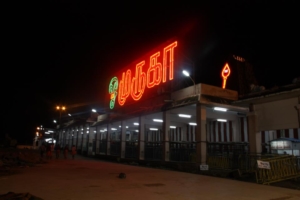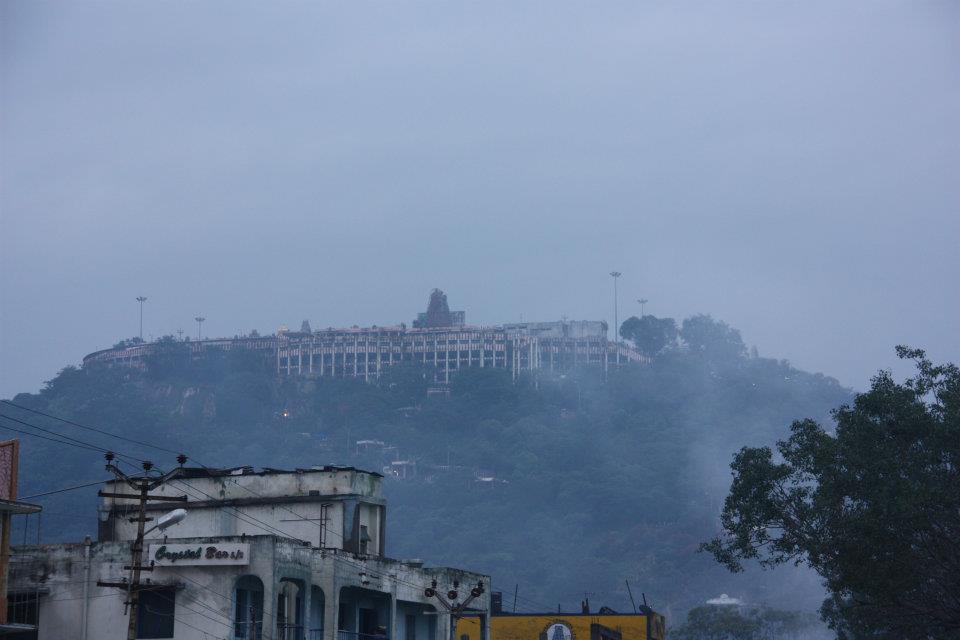Palani is a town located in Dindigul district of Tamilnadu .It is 62 miles south-east of Coimbatore, 100 km north-west of Madurai, 60 km Kodaikanal. The temple is proudly called as Palani Muruga temple or Dhanda yudhapani temple.
The Palani Murugan Temple, also known as the Arulmigu Dhandayuthapani Swamy Temple, is a renowned Hindu temple dedicated to Lord Murugan (also known as Lord Karthikeya) located in the town of Palani in the Dindigul district of Tamilnadu , India.
Here are some key details about the Palani Murugan Temple:
- Importance and Legend: The Palani Murugan Temple is considered one of the six abodes (Arupadai Veedu) of Lord Murugan and holds great religious significance among devotees. According to the legend, Lord Murugan appeared in Palani to resolve a dispute between his parents, Lord Shiva and Goddess Parvati. The temple is believed to have been built on the spot where this divine incident took place.
- Architecture: The temple’s architecture reflects the Dravidian style and showcases intricate carvings and sculptures. The main shrine, known as the Garbha Griha, houses the idol of Lord Murugan in a standing posture, holding a Vel (sacred spear). The temple complex also includes various other halls, shrines, and towers.
- Steps and Rope Car: One of the unique features of the Palani Murugan Temple is the significance of climbing steps as an act of devotion. The temple hill has 693 steps, and devotees climb them as a form of penance and to seek the blessings of Lord Murugan. For those unable to climb the steps, there is a rope car facility available for transportation to the hilltop.
- Festivals: The temple celebrates various festivals throughout the year, with the most significant one being the Thaipusam festival. During Thaipusam, devotees undertake elaborate processions, carry Kavadi (ornate structures), and engage in acts of devotion to Lord Murugan. The festival attracts a large number of devotees from all over the country.
- Prasadam: The Palani Murugan Temple is known for its famous prasadam, known as Panchamirtham. Panchamirtham is a sweet concoction made with five main ingredients: jaggery, banana, ghee, honey, and cardamom. It is believed to have divine blessings and is offered to devotees as a sacred offering.
The Palani Murugan Temple is not only a significant pilgrimage site but also a place of spiritual and cultural importance. Devotees visit the temple to seek blessings, perform rituals, and experience the divine presence of Lord Murugan.
History of origin words:
The word Palani is derived from the joining of two words pazham and nee. A mentioned to poet avvaiyar, praised Lord Muruga by many songs
NARRATIVE:
From ancient Tamil devotional texts,” sage naradar wanted to see Lord Shiva, so he visited mount Kailash to present him a gyana-pazham[gyana- wisdom;pazham- fruit].

LORD MURUGA’S BOYHOOD:
When sage gave gyana- pazham to lord Shiva. He dedicated to awarding whomever of his two sons first circle around the world three times. Both of them accepted the challenge.
lord, Muruga started his journey to circled the globe with his peacock. But, Ganesha thought, that the world was his parents Shiva and Shakti.
So, Ganesha circled his parents and awarded by the fruit from his father Lord Siva. When Muruga came, he was too angry to hear that his hard work had been in useless.
So, he left mount kailash and took up his stay at Palani hills in south India.
Muruga gets matured from his boyhood. He chose to remain as a hermit and throw out all his clothes and jewels.he wanted to know his himself. So, he went into meditation.
About temples:
Palani is one of the holy shrines of Lord Muruga. Thandayudhapani temple is one of his arupadai veedu is located here. The sanctum santorum is surmounted by a gold gopuram. inside this, Lord Muruga situated.
Bogar made this Muruga by 9 navapasanangal. Navapasnangal is protected against illness.
At the foothills of the Palani a temple called Thiru avinan kudi and also called kulandhai velayudhaswami thiru kovil. each year more than 7 millions of devotees visited to the temple. The sanctum Sanctorum’s mentioned about the devotees offering to the temple.
Geographical information:
The town’s view depends on the two hills sivagiri and sakthigiri. At the foot of the hills lie various ponds which drain to the Shanmugam river. It is a tributary river of amaravathi, itself a tributary of the Kaveri river.
